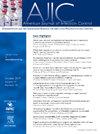Challenges and trends in Gram-negative bacterial infections in critically neonates: A seven-and-a-half-year observational study
IF 3.8
3区 医学
Q2 INFECTIOUS DISEASES
引用次数: 0
Abstract
Background
Analyze the incidence, risk factors, and fatality rates of bloodstream infections by Gram-negative bacteria (GNB-BSIs) in a Neonatal Intensive Care Unit.
Methods
This study employs a retrospective cohort design utilizing records of neonates admitted to the Neonatal Intensive Care Unit between January 2015 and June 2022.
Results
Among 1,495 neonates, 5.2% developed GNB-BSIs. The average incidence of infection per 1,000 patient-days was 2.9. Primary risk factors for infection that included preceeding carbapenem use were significant risk factors (odds ratio = 514.4; P < .01) and fourth-generation cephalosporins (odds ratio = 66; P < .01). Among the 85 GNB, 75.3% were fermenters, and 24.7% were non-fermenters. Of the isolates, 14.1% produced extended-spectrum beta-lactamase, and 2.3% carbapenem-resistant. Infection correlated with prolonged hospital stays (10-39 days) and increased mortality (10%-29.9%).
Conclusions
The high incidence of GNB-BSIs was exacerbated by the preceeding use of broad-spectrum antimicrobials, increasing the presence of multidrug-resistant isolates and fatality rates. These findings emphasize the importance of active surveillance.
重症新生儿革兰氏阴性菌感染的挑战与趋势:一项为期七年半的观察研究。
目的分析新生儿重症监护室(NICU)中革兰氏阴性菌血流感染(GNB-BSIs)的发病率、风险因素和死亡率:本研究采用回顾性队列设计,利用2015年1月至2022年6月期间新生儿重症监护室收治的新生儿记录:结果:1495 名新生儿中有 5.2% 感染了 GNB-BSI。每千个患者日的平均感染率为 2.9。感染的主要风险因素包括:使用碳青霉烯类药物之前是重要的风险因素(OR=514.4;第四代头孢菌素(OR=66;PC)结论:GNB-BSI 的高发病率对新生儿的影响非常大:在使用广谱抗菌药物之前,GNB-BSI 的高发病率加剧,增加了耐多药分离株的存在和死亡率。这些发现强调了积极监测的重要性。
本文章由计算机程序翻译,如有差异,请以英文原文为准。
求助全文
约1分钟内获得全文
求助全文
来源期刊
CiteScore
7.40
自引率
4.10%
发文量
479
审稿时长
24 days
期刊介绍:
AJIC covers key topics and issues in infection control and epidemiology. Infection control professionals, including physicians, nurses, and epidemiologists, rely on AJIC for peer-reviewed articles covering clinical topics as well as original research. As the official publication of the Association for Professionals in Infection Control and Epidemiology (APIC)

 求助内容:
求助内容: 应助结果提醒方式:
应助结果提醒方式:


